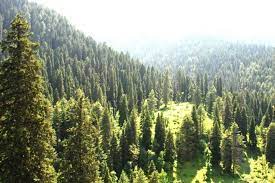Supriya Sharma
The forest resources are known as the ‘Green Gold’ because they are precious like gold and should be protected more than gold. They help in preserving the ecosystem, soil conservation, acts as home for birds and animals, also provide food as well as timber for construction. The weather is also optimized in the summers if the forests are present as the trees help to cool down the wind and act as natural air conditioners for the nearby areas.
We can appreciate this fact in the Jammu city and adjoining areas where the temperature in summers reached record high while this was not the case 50 years back. Our grandparents told that whenever there was increase in temperature the rains used to lash our city but due to excessive cutting of trees for developmental and construction activities, Jammu has become a concrete jungle and this is the reason for such an increase in temperature here.
This phenomenon is not localized but is seen world over where the deforestation is taking place which inturn is leading to global warming.
The spatial distribution of different types of natural vegetation of J&K state is divided into following types:
* Temperate forest: The wide slopes of Pir Panjal, Greater Himalayas, Zanskar and Karakoram between 1,500 m to 3,000 m are fully dominated by temperate forests. The species usually present in these forest are dominated by deodar (cedrus Deodara), pine (pinus), silver fir, spruce, fir, elm, cedar, ash, birch, paper-birch and hazel.
The northern slopes of Pir Panjal have the dominance of deodar, blue-pine and the Jhelum Forest Division (stretching over Gulmarg and Lolab valley) is dominated by cedar, fir and spruce species of conifers. Therefore on the beneficial part, the temperate forests are utilized for timber, fuel wood, charcoal and house construction.
The depletion of most valuable timber forest of deodar became confined to the north western corner of Kashmir Division. The over exploitation of forests and the use of soft and costly wood for fuel are great harm to the UT revenue as well as the aesthetic beauty of the UT and importantly the ecosystem on the whole earth. In fact many of the ecosystems have lost their resilience characteristics.
* Alpine Pastures: the grasses belonging to the higher regions of J&K mountain system is known as Margs or alpine pastures. The alpine pastures lie between 3600m to 4000m, above the sea level. The climate of alpine is extremely cold for most part of the year. In the month of May to September (in summer season) the ice melts at high altitude and lush green grasses grow. The dwarf varieties of birch and junipers are the shrubs present in these regions.
The lush green and nutritious grasses of alpine pastures are utilized and grazed by the Gujjars and Bakarwals (goat herders) who practice transhumance. They stay in Margs pastures upto the middle of September, depending on the prevailing temperature and precipitation conditions.
Subtropical forests: The subtropical rain forests are confined to the Siwaliks and lower slopes of the Middle Himalyas. Due to rainfall and favorable moderate climate and edaphic factors, there is a wide range of vegetations. The bushes and scrubs both are present in these region. The dominant species of subtropical forests are teak, sal, shisham, pipal (Ficus religious). Silver pine, Tun, Mohowa, Khair, thorny bushes, climbers, evergreen shrubs and tall grasses locally called as Khar. Most of these species are broad-leaved deciduous type. The trees shed their leaves in the months of January, February and March. These forests are mainly utilized for fuel wood, timber, house construction etc. The forest produce beneficial products like resins, gum, katha, and medicinal herbs are also obtained from the subtropical forests of the UT.
The forest cover of the J&K is diminishing. The forest are being destroyed and depleted at faster pace. The immense pressure due to over population and ignorance of people are quickly damaging the ecosystem of these forests.
Forests act as lungs for the nature. It purifies and oxygenate the air we inhale. It’s also the home for various species of plants and animals. Governments have realized the importance of trees in the city areas and that’s why they are planting trees under the urban forestry programs and to aware general public about the importance of greenery around us. NGO’s are also working for the preservation of the forests and renewal of the depleted forests.
You will appreciate the fact that University of Jammu is one such area which is full with trees all around. There is a definite difference of temperature in the campus as it is 2 to 3 degrees lower than the adjoining places. That’s why the campus is live with the morning and evening walkers as people love to walk here. The environment is calm and relaxed only because it’s a green campus.
We all must work together to rejuvenate the lost ‘Green Gold’ by proving our small support in planting the trees in our homes as well as locality. It would be excellent if we could plant some fruit trees so that we can get fresh fruits free of any chemical spray or fertilizer in our locality. Parents must encourage their children to plant atleast 5 fruit trees every year on their birthday and by doing this our coming generations would definitely get the benefit of clean and cool surroundings and appreciate our effort to save the environment.
(The author of this article is a PhD Scholar in the Department of Zoology, University of Jammu)
Trending Now
E-Paper


